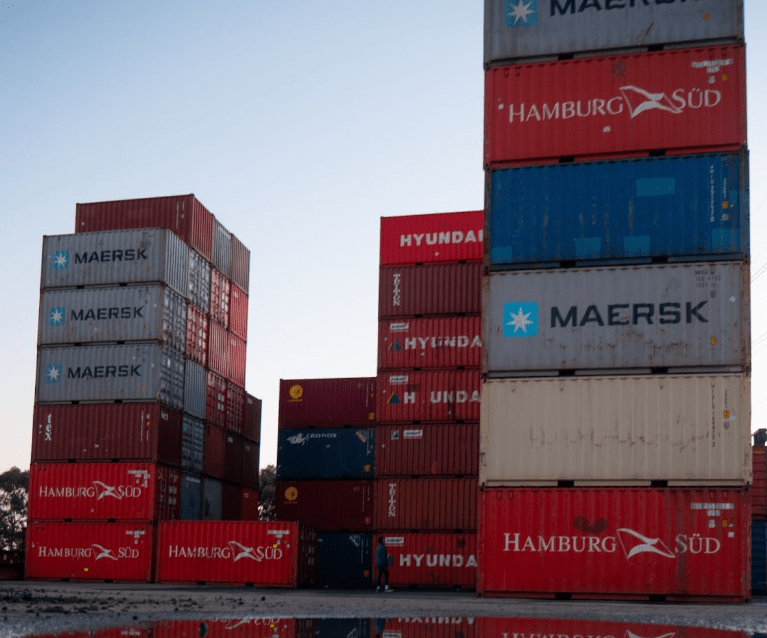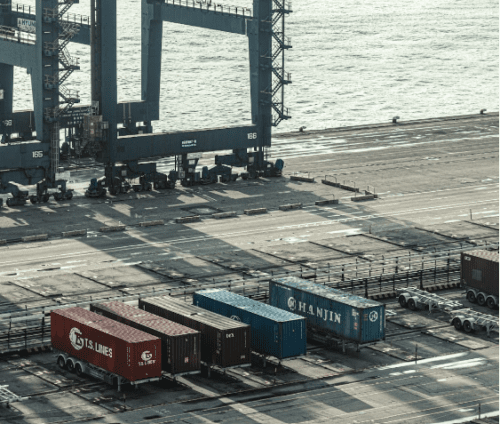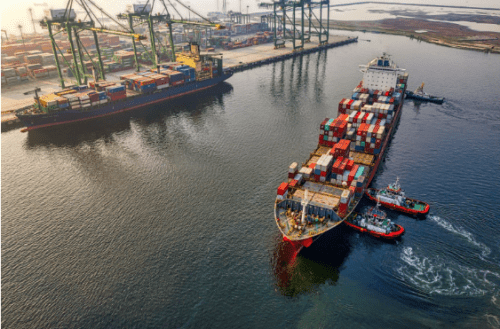Intermodal vs. Multimodal: Definition and Advantages

Shippers save money and time by choosing multimodal and intermodal transportation. While both methods use many transportation modes, they differ in who is responsible for your shipment.
Even though it might be easier to work with just one shipping company, it is often more cost-effective to leverage the knowledge and services of more than one. But that means the logistics can become more challenging to manage. If you want to get the most out of multimodal and intermodal transportation networks, you need to understand how they work.
To help you decide the best method for your goods, let’s go through the advantages of intermodal and multimodal transportation.
What is Intermodal Transportation?
Intermodal transport is the conveyance of goods from their origin to their destination by more than one transportation method, each of which is operated by a separate carrier under separate contracts.
A different shipping company deals with each part of the trip. This means the shipper must manage different contracts, one for each transport company involved in the shipment’s various legs.
It may be possible to work out the best possible door-to-door shipping price by combining the services of many different transport companies.
However, intermodal transport is not without its drawbacks. For one, if you’re looking for cheaper shipping options, you might have to compromise on delivery time and the efficiency of your shipping routes.
And while you may save money, you’ll have to put in more time and effort coordinating logistics and doing the legwork yourself.
Naturally, there can be holdups when you rely on several companies to fulfill their contracts on time. Remember that it will be up to you to handle the resulting delays. Since the carriers aren’t working under the same contract, they are sometimes in the dark about delays and schedule changes. You’ll need to act as the go-between to get shipments back on track.
Types of Intermodal Transportation
There are two types of intermodal transportation: Container-On-Flat-Car (COFC) and Trailer-On-Flat-Car (TOFC). They cut down on manual labor and save shippers time, effort, and money.
Container-On-Flat-Car (COFC)
COFC is the solution if you seek a practical and affordable intermodal transportation technique. Here, a “well car”—also referred to as a double-stack car or stack car—can be concurrently loaded with four containers.
Trailer-On-Flat-Car (TOFC)
Carrying semi-trailers on flatcars on railroads is a technique known as trailer-on flatcar (TOFC), or piggyback. Since one train can transport more than 100 trailers at once, TOFC enables shippers to transfer truckloads over long distances more affordably than they could by having each trailer carried by a truck.
Advantages of Intermodal Transportation
There are many benefits to intermodal transportation, even though it involves a fair amount of complexity. Intermodal shipping generally provides more options for equipment, capacity management, and transit time selection.
Let’s examine the benefits of intermodal transportation in greater detail.
Choice of Carrier
A common reason for using intermodal transportation is that it offers a variety of transport carriers from which to choose. This gives you the freedom to pick the one that offers the best service and rates.
For example, if you want to ship your freight from Chicago to Los Angeles, several providers offer different services (e.g., door-to-door delivery). You can decide whether you want an expedited shipment or one that’s cheaper but slower.
When you choose transport carriers, you can negotiate arrangements with each business separately to get the best deal possible. You can also choose carriers that will consolidate your shipments with another shipper so you share the cost of transportation.
For example, if you want to send 5,000 pounds of freight from Chicago to Los Angeles and another company needs to ship a 4,500-pound shipment in the same direction, you can pool your resources together. This will reduce the cost of using multiple carriers.
Shippers can renegotiate for lower prices for each leg of the trip with different transport carriers for different transport modes. It’s also a good idea if you need to ship your goods quickly and can’t afford to wait for one carrier’s transit schedule.
Reduces Carbon Footprint
If you are invested in reducing your carbon footprint, choosing environmentally friendly carriers is easier than ever. These carriers use less fuel and produce fewer emissions. The EPA provides a list of green shipping companies that can help you find environmentally friendly options for your freight.

By analyzing, benchmarking, and enhancing the effectiveness of freight transportation, the EPA’s SmartWay initiative helps businesses advance supply chain sustainability.
C&K Trucking is one top-rated trucker that collaborates with the Environmental Protection Agency’s SmartWay Transportation Program. The company concentrates on technology and operational improvements to help achieve more miles per gallon and lower overall carbon dioxide emissions. The corporation has refitted vehicles, installed software to evaluate efficiency measures, and developed new speed control guidelines.
Even though all shipping methods produce some emissions, intermodal shipping is the most eco-friendly method of transportation over land.
Here are some statistics on how intermodal train transportation affects the environment:
- An intermodal train has the capacity of 280 trucks.
- A ton of freight may be transported 450 miles by rail using just one gallon of fuel.
- Unlike vehicles, trains produce only around 5.4 pounds of carbon dioxide every 100-ton miles.
- Vehicles used in intermodal service result in approximately 7 tons of carbon emissions, as opposed to trucks transporting 40,000 lbs., each traveling 3,000 miles.
In addition to these figures, the number of cars on the road decreases as more freight is transported via intermodal. The EPA predicts that every ton-mile of freight that moves by rail rather than by roadway may cut carbon emissions by two-thirds, thanks to the added efficiency of rail and less traffic congestion.
Intermodal becomes a more attractive choice as businesses take environmental and sustainability responsibility into account, in addition to rising gas costs.
Security
If you’re concerned about security, intermodal transport may be your best bet.
More freight is transported by railroad than by over-the-road (OTR). It is more challenging to gain access to the freight because the train never stops unless it is behind a secured intermodal ramp.
The freight is not left unattended, as can happen with an OTRshipment, and the container cannot be reached while on the wellcar (you cannot open the lower container’s doors).
Flexibility
Intermodal transportation offers flexibility to shippers by providing the option of taking a cheaper or more direct route. In particular, shippers that use rail freight, frequently more direct than trucks, can attest to this.

It’s much easier to change your shipping plans when working with multiple carriers than to make changes with just one. You can do so if you need to reschedule or cancel a shipment.
This option is best for businesses that want to save money on freight shipping by using multiple carriers and need flexibility in their shipping schedules.
What is Multimodal Transportation?
Multimodal transportation refers to a method of transportion that uses two or more modes to get goods from one location to another while requiring only one bill of lading (BL).
A Multimodal bill of lading, also known as a Combined Transport Bill of Lading, is a legal document that specifies the kind, amount, and final destination of goods transported from one location to another. When the carrier drops off the shipment at its final destination, the bill of lading doubles as a receipt for the package.
When the contracted carrier issues a BL, the document travels with the shipment, from country to country if necessary, until it reaches its final destination. As a result, the carrier bears full responsibility for the carriage, regardless of the means or company providing the transportation.
Multimodal shipping employs just one organization or contract for the entire shipment process. This means that the same business will be accountable for every transport leg of your package, regardless of travel mode.
You will not be held liable for any problems related to shipment tracking, delivery time, or other intermodal shipping issues when employing a single carrier.
The agent handles the behind-the-scenes negotiations, leaving you with only a single contract to manage. Agents may also be tasked with arranging loading and unloading and dealing with delays.
With this type of transportation, you gain the benefits of using a single carrier without having to worry about any of the details. That also means you won’t have control over the choice of carriers or routes, but it may also mean that you save on your total shipping cost.
Advantages of Multimodal Transportation
Multimodal transportation offers many benefits, even though you essentially hand control over to a shipping company.
Multimodal shipping generally provides more insulation from disruption. Multimodal shipping businesses have mechanisms to handle cargo issues, schedules, and price negotiation.
Because of this, the multimodal shipping system provides an enclosed, all-inclusive solution where a single business addresses all your needs.
Let’s examine the benefits of multimodal transportation in greater detail.
Reduced Costs
The multimodal transportation method has several advantages, including reduced freight costs for the shipper.
It reduces inventory costs by reducing the number of shipments you have to make and by eliminating unnecessary paperwork.
Additionally, multimodal transportation reduces shipping costs by using one carrier for multiple legs of your journey. By combining sea freight and rail transport, you can save money on fuel and the total shipping cost.
Reduced Delivery Time
Multimodal transport can also reduce your delivery time. When you use a combination of different modes of transport, carriers can deliver the shipments faster than if they were shipped by only one transportation mode.
For example, if you ship a product from China to the United States by sea freight and then by rail, the journey might take weeks longer than if you ship by air. This shipping method will allow you to send more goods in less time.
Centralized Responsibility
Centralized responsibility is created when a separate transport carrier is in charge of transporting the goods across all legs and in all modalities.
A single company–referred to as the multimodal transport operator (MTO)–coordinates all modes of transportation using a transportation management system, and bills at a single, all-inclusive fee.
The duties of the multimodal transport operator are as follows:
- Maintains the smooth functioning of the organization’s logistics system
- Plans the movement of commodities and freight by various modes of transport, such as trucks, trains, airplanes, and ships, so that they arrive at their destination or shipping port on schedule and in excellent condition
- Contracts with third-party logistics providers
- Controls the operations of rail and harbor freight used to handle cargo and other bulk shipments
- Develops and sustains working partnerships with shipping and delivery firms outside their own company
- Finds ways to fulfill shipments at a reasonable price
- Examines budget reports to find and suggest changes to be made to lower transportation expenses
Shipment Tracking Efficiency in Multimodal Transport
Since the sea covers most of the distance in multimodal transportation, third-party logistics software makes it easier to monitor the containers in real time.
This enhances shipment efficiency and offers more thorough shipping insights. Over time, you can use this valuable transportation management system data source to improve your supply chain’s efficiency and make more cost-effective business decisions.
Final Thoughts on Intermodal and Multimodal Transportation
There are benefits and drawbacks to both intermodal and multimodal freight transportation systems. Still, there is one key difference between intermodal and multimodal transport. With multimodal, you sign a single contract, employ a Bill of Lading, and use the same transport carrier. With intermodal, you sign many contracts and do more logistics coordination.
While both intermodal and multimodal forms of transportation minimize overhead and maximize efficiency, many businesses prefer multimodal transportation when considering price and ease of using one transport carrier.
